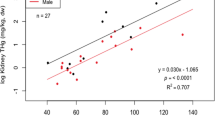Abstract
Hg was analyzed in seven tissues of 52 common shoveler Anas clypeata collected from the coast of SE Gulf of California. Mean Hg concentrations were highest in the liver (2,885 ng g−1) and lowest in the gizzard (621 ng g−1); they followed the order: liver, feathers > muscle tissue and tissues of the circulatory system > digestive organs. Hg levels were similar or higher than birds of the same trophic level and feeding habits. Considering the relationships of Hg among tissues and blood we recommend the use of blood as an efficient method to monitor Hg.




Similar content being viewed by others
References
Bianchi N, Ancora S, Fazio ND, Leonzi C (2008) Cadmium, lead, and mercury levels in feathers of small passerine birds: noninvasive sampling strategy. Environ Toxicol Chem 27:2064–2070
Burger J, Gochfeld M, Jeitner C, Snigaroff D, Snigaroff R, Stamm T, Volz C (2008) Assessment of metals in down feathers of female common eiders and their eggs from the Aleutians: arsenic, cadmium, chromium, lead, manganese, mercury, and selenium. Environ Monit Assess 143:247–256
Eagles-Smith CA, Ackerman JT, Yee J, Adelsbach TL (2009) Mercury demethylation in waterbird livers: dose—response thresholds and differences among species. Environ Toxicol Chem 28:557–568
IAEA (1987) Intercalibration of analytical methods on marine environmental samples. Trace element measurements on fish homogenate. Results of the Worldwide 130 Intercomparison Run MA-B-3/TM Report 36. IAEA, Monaco
INEGI (2011) Mapas de climas. http://mapserver.inegi.org.mx/geografia/espanol/estados/sin/clim.cfmc=444&e=05. Accessed 9 June 2011
Kim EY, Ichihashi H, Saeki K, Atrashkevich G, Tanabe S, Tatsukawa R (1996) Metal accumulation in tissues of seabirds from Chaun, northeast Siberia, Russia. Environ Pollut 92:244–252
Lamborg CH, Fitzgerald WF, O’Donnell J, Torgersen T (2002) A non-steady-state compartmental model of global-scale mercury biogeochemistry with interhemispheric atmospheric gradients. Geochim Cosmochim Acta 66:1105–1118
Lewis SA, Furness RW (1991) Mercury accumulation and excretion in laboratory reared Black-headed Gull Larus ridibundus chicks. Arc Environ Contam Tox 21:1316–1320
Lewis SA, Becker PH, Furness RW (1993) Mercury levels in eggs, tissues, and feathers of herring gulls Larus argentatus from the German Wadden sea coast. Environ Pollut 80:293–299
Páez-Osuna F, Calderón-Campuzano MF, Soto-Jiménez MF, Ruelas-Inzunza JR (2011) Mercury in blood and eggs of the sea turtle Lepidochelys olivacea from a nesting colony in Oaxaca, Mexico. Mar Pollut Bull 62:1320–1323
PNUMA (2005) Programa de la Naciones Unidas para el Medio Ambiente. Evaluación Mundial Sobre el Mercurio. http://www.chem.unep.ch/mercury/GMA%20in%20F%20and%20S/final-assessment-report-Nov05-Spanish.pdf. Accessed 10 Dec 2012
Pokras MA, Hanley C, Gordon Z (1998) Liver mercury and methylmercury concentrations in New England common loons(Gavia immer). Env Tox Chem 17:202–204
Robinson SA, Lajeunesse MJ, Forbes MR (2012) Sex differences in mercury contamination of birds: testing multiple hypotheses with meta-analysis. Environ Sci Technol 46:101–7094
Ruelas-Inzunza JR, Hernández-Osuna JA, Páez-Osuna F (2009) Organic and total mercury in muscle tissue of five aquatic birds with different feeding habitats from the SE Gulf of California. Chemosphere 76:415–418
Zamani AR, Esmaili-Sari A, Ghasempouri SM, Savabiesasfahani M (2009) Mercury in wetland birds of Iran and Iraq: contrasting resident moorhen, Gallunula chloropus, and migratory common teal, Anas crecca, life strategies. Bull Environ Contam Toxicol 82:450–453
Acknowledgments
M.S. fellowship to JRRV has been provided by CONACYT. Thanks are due to H. Bojórquez-Leyva, M.C. Ramírez-Jáuregui, G. Ramírez-Reséndiz, and C. Suárez-Gutiérrez, for technical assistance (chemical analysis, bibliographic research and data analysis). This project was funded by the Ministry of Public Education (Project REDES PROMEP/103.5/12/4812).
Author information
Authors and Affiliations
Corresponding author
Rights and permissions
About this article
Cite this article
Raygoza-Viera, J.R., Ruiz-Fernández, A.C., Ruelas-Inzunza, J. et al. The Use of Blood in Anas clypeata as an Efficient and Non-lethal Method for the Biomonitoring of Mercury. Bull Environ Contam Toxicol 91, 42–48 (2013). https://doi.org/10.1007/s00128-013-0995-6
Received:
Accepted:
Published:
Issue Date:
DOI: https://doi.org/10.1007/s00128-013-0995-6




